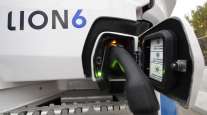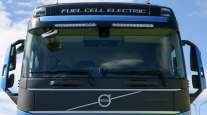Senior Reporter
NACFE Report Predicts Multiple Fuels Will Give Way to Battery-Electric

[Stay on top of transportation news: Get TTNews in your inbox.]
The North American Council for Freight Efficiency forecasts commercial battery-electric vehicles and fuel cell trucks will be capable of lower total cost of ownership, compared with baseline diesel trucks, in the 2030 time frame.
By 2040, commercial battery-electric vehicles will use clean well-to-wheel energy, and dominate the industry as batteries last longer, weigh and cost less, and fast-charging stations are everywhere, the group added.
The findings were included in NACFE’s latest guidance report: “Viable Class 7/8 Electric, Hybrid and Alternative Fuel Tractors.”
For the near future, the report also pointed out NACFE believes no single solution will replace diesel because specialization and regional factors, instead, are pushing the market to a multifuel future, where many of these technologies will coexist.
The NACFE report refers to the period from 2030 to 2040 as the “messy middle” where there will be many optimized solutions, multiple fuel choices, growing infrastructure, learning curves, more innovation and maturation, and facts replace estimates.
“Although many manufacturers are ramping up initial production lines for the 2020-2025 time frame, significant production volumes of these new technologies are likely not feasible until the latter half of the decade, making it difficult to gather data from field experience,” according to the report. “This lack of real-world data combined with several competing choices means fleets are likely overwhelmed by these new choices.”

Roeth
“This [report] is particularly interesting given everything that is going on in the industry,” said Mike Roeth, NACFE’s executive director. “This segment burns the most fuel and gathers the most attention because of that.”
Roeth also said owners may eventually keep these alternative powered trucks longer because they are performing better in their duty cycles “because they have been specifically specified for them.”
At the same time used-truck buyers may not find those same trucks as applicable for them, as are typical diesel trucks that change hands now. “So we envision the ability to move [alternative powered] trucks in the second and third markets more challenging.”
Roeth told Transport Topics as of now there are “not many retrofit options,” although some hybrid diesel options are available.
Meanwhile, an industry consultant believes it is harder to predict what the situation will be in 2040.
“I am less convinced that once we are through the ‘messy middle’ there will be a clear single winner,” Patrick Couch, senior vice president of technical services at Gladstein, Neandross & Associates, told TT.

RoadSigns asks: Is Trucking Charging Toward an Electric Reality? Could what’s happening at the ports of Southern California have consequences for the way the rest of the nation experiences an electric future? Listen to a snippet above from Volvo's Keith Brandis, and get the full program by going to RoadSigns.TTNews.com.
Although there is an “important trend” toward electrification of the powertrain, “whether that involves a power source using batteries or hydrogen or something else that we haven’t thought through is still to be determined,” he said.
Gladstein, Neandross & Associates is a California-based clean transportation and energy consulting firm, and producers of the Advanced Clean Transportation Expo.
Meanwhile, a fleet executive expects the “messy middle” to be shorter than NACFE expects.
“I don’t see it being that ‘messy middle’ until 2040. I see it having a shorter life,” said Bill Bliem, senior vice president of fleet services at NFI Industries Inc. “I don’t know how short that is. It may take 15 or it may take 10.”
NFI by 2025 will have 35% to 50% of its fleet be zero emissions, depending who in upper management is discussing the shift, said Bliem. “We are looking at 800 to 900 tractors.”
It is already adding battery-electric tractors at an introductory pace, as well as a growing number of near-zero natural gas tractors.
NFI — with truckload, dedicated contract carriage, and flatbed/heavy specialized units — operates about 2,300 company-owned tractors and uses 1,700 owner-operators.
NFI ranks No. 19 on the Transport Topics Top 100 list of the largest for-hire carriers in North America.
NFI Distribution is involved in warehousing and distribution, cross-docking, order fulfillment and contract packaging.
Want more news? Listen to today's daily briefing:




